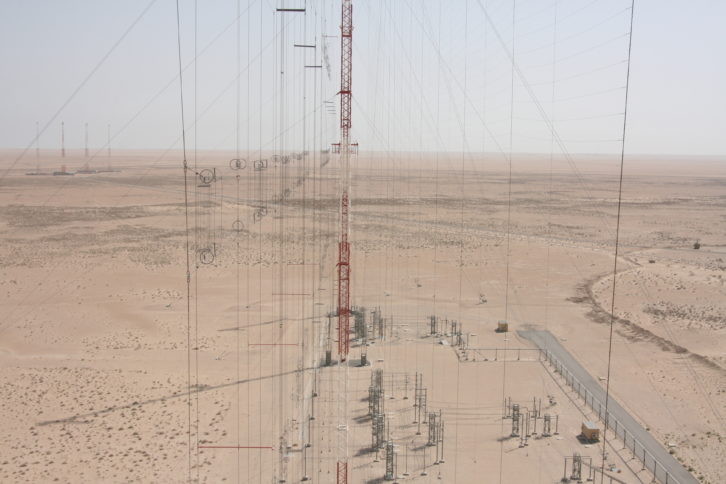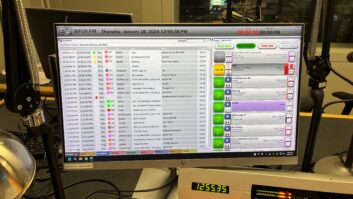Russia’s horrific invasion of Ukraine and its simultaneous blocking of Western media outlets has renewed public interest in shortwave radio broadcasters like the federally funded Voice of America.
Now managed by the U.S. Agency for Global Media or USAGM, VOA’s roots go back to 1941, when the U.S. government leased a dozen commercial broadcaster owned/operated shortwave radio transmitters for the VOA’s predecessor, the U.S. Foreign Information Service. (These shortwave transmitters were previously used by U.S. broadcasters to share content between their AM radio stations.)
The VOA came into being in 1942. It played a major role in broadcasting U.S. news and views to the world during World War Two and the Cold War. After the fall of the Berlin Wall, shifting government priorities, the emergence of platforms competing with shortwave, and budget cuts led to VOA’s language services, broadcasts and programming being reduced.
Today, “USAGM operates transmitting stations around the world, including in the U.S., Africa, Europe and Asia,” Laurie Moy, USAGM’s director of public affairs said in an email earlier this year.
“All of these stations are equipped with multiple shortwave transmitters, and four of these stations have a medium-wave (AM) transmitter each. In total, USAGM’s network consists of about 75 shortwave (ranging from 100 to 250 kW) and medium-wave (ranging from 100 to 1000 kW) transmitters.”
The agency also has access to shortwave and medium-wave transmitters via leases and exchange agreements with other broadcasters.
At present, USAGM produces content in 63 languages, 35 of which are aired on shortwave and medium-wave. VOA itself produces content in 48 languages, 18 of which are aired on shortwave and medium-wave.
“In terms of the agency’s shortwave network, shortwave continues to reach particularly difficult-to-reach audiences, such as in North Korea, western China, Afghanistan and elsewhere,” Moy told Radio World.
Shrinkage and growth
In its heyday, VOA had major U.S. shortwave transmitter/antenna sites at Greenville, N.C.; at Bethany, Ohio; and at Delano and Dixon, both in California.
“The only VOA transmitter that exists in the U.S. today is Site B at Greenville, which was opened in 1963 by John F. Kennedy himself,” said Dan Robinson, a retired VOA correspondent, language service chief and longtime shortwave enthusiast.
“Internationally,” said Gerhard Straub, who retired last year as director of the USAGM’s Broadcast Technologies Division, “there have been no significant reductions in the shortwave infrastructure. The last significant reduction was when the Sri Lanka transmitting station was closed after suffering significant storm damage. At that time, transmitters from Sri Lanka were moved to other transmission sites, notably the Greenville station, to modernize it a bit.”
Moy agreed: “Other than closing the Sri Lanka station, USAGM has made no other significant changes to the network since 2017, except to maintain and repair equipment as needed. At our station in the Northern Mariana Islands, where a typhoon destroyed the transmission infrastructure in October 2018, USAGM has been repairing or replacing the damaged antenna arrays.”
On the flip side, said Straub, “There is a major project underway to increase shortwave capability at the Kuwait transmitting station, in addition to a new antenna that was added a couple of years ago. This project is adding antennas and transmitters to provide additional coverage of Africa. USAGM also added Digital Radio Mondiale capability at the Greenville transmitting station to experiment with that mode in a project with the Office of Cuba Broadcasting.”

Reliance on other platforms
In recent years, VOA, Radio Free Europe/Radio Liberty and other U.S. government broadcasting services have increasingly relied on non-shortwave platforms to get their messages across to international listeners.
“A key goal for USAGM is to deliver programming to audiences on the platforms they prefer, despite the instabilities and evolution of media markets,” said Moy. “USAGM continues to see year-on-year growth of its radio audiences — USAGM’s weekly audiences on radio platforms in 2021 total 142 million people — and virtually all of this growth comes from local rebroadcasts and USAGM’s own FMs.
“While TV remains the most popular platform for USAGM audiences overall, audiences on digital platforms are the fastest growing and now surpass radio audiences,” she continued. “Digital platforms include not only websites and social media, but also on-demand video apps, podcasts, streaming services and more.”
Dan Robinson has written critically about VOA’s audience methodology and expressed skepticism about these audience numbers. “You’ll see situations where VOA signs a rebroadcast agreement with some TV or radio station in, let’s say, Northern Nigeria, and then instantly tack on that broadcaster’s own audience claims to VOA’s global reach numbers,” he said. “But this does not mean that VOA is actually reaching that entire audience.”
But Moy pushed back on that.
“Mr. Robinson’s research-based assertions are incorrect. We do not count an affiliate’s total audience as our own. We conduct our own nationally representative surveys, adhering to standards developed by the Conference of International Broadcasters’ Audience Research Service. In these surveys we ask about the reach of our brands — for example VOA — and the reach of specific programs with clear brand names, such as Africa 54. Once someone says they consume our brand or our program, then we ask where they consume it, including questions about whether they’re watching/listening on a named partner station.”
Local AM/FM/TV rebroadcasts and websites can be vulnerable to hostile regimes shutting them down. But VOA does not intend to follow the BBC World Service’s lead and reintroduce shortwave broadcasts to this region.
“Our research indicates there are few shortwave sets in use in that part of the world, so it’s not in our current plan to add shortwave broadcasts,” said Bridget Ann Serchak, VOA’s director of public relations earlier this year. “However, we have begun a satellite TV channel to provide additional content for audiences in Ukraine and are exploring other methods of transmission.”
No major shortwave revival
One thing seems certain: A global rebuild/expansion of VOA’s shortwave infrastructure is not in the cards.
“In some areas shortwave is not considered as important as it used to be, mainly due to the proliferation of other media platforms such as internet and satellite-based systems and the media consumption habits of the target demographic in those areas,” Straub said.
“However, in other geographical areas such as Africa, shortwave continues to be very important, as evidenced by the addition of USAGM shortwave capability to this area.”
This is a position that makes sense to Dan Robinson, much as he wishes it didn’t.
“There’s a difference between what I would like to see as someone who was always interested in shortwave and saw the impact that it used to have, and what I think makes sense today,” he said. “At the same time, much of the shrinkage has been driven by VOA, BBC and other broadcasters pulling back from shortwave and their listenership falling as a result, not vice versa.”
Acting Chief of Staff Gary Butterworth noted that VOA’s second-newest language, Rohingya, launched in July 2019 exclusively on shortwave and medium-wave.
“It’s certainly true that the world seems to be moving on from these bands, but they’re not entirely dead yet, and we certainly haven’t forgotten about them,” he told Radio World.
What remains to be seen is how the apparent drop of a new “Iron Curtain” across parts of Eastern Europe affects the West’s ability to reach listeners there. Even today, shortwave’s advocates say that SW remains the cheapest, easiest to conceal and hardest to block option for listeners in Ukraine, Russia and other countries of interest to Vladimir Putin.
Comment on this or any story. Email [email protected] with “Letter to the Editor” in the subject field.
Find more of the author’s stories about all aspects of international radio at www.radioworld.com/author/jamescareless.












